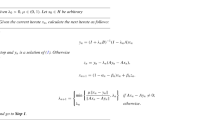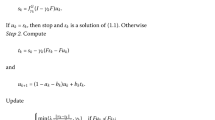Abstract
We consider the problem of reconstructing an infinite set of sparse, finite-dimensional vectors, that share a common sparsity pattern, from incomplete measurements. This is in contrast to the work (Daubechies et al., Pure Appl. Math. 57(11), 1413–1457, 2004), where the single vector signal can be infinite-dimensional, and (Fornasier and Rauhut, SIAM J. Numer. Anal. 46(2), 577613, 2008), which extends the aforementioned work to the joint sparse recovery of finite number of infinite-dimensional vectors. In our case, to take account of the joint sparsity and promote the coupling of nonvanishing components, we employ a convex relaxation approach with mixed norm penalty ℓ2,1. This paper discusses the computation of the solutions of linear inverse problems with such relaxation by a forward-backward splitting algorithm. However, since the solution matrix possesses infinitely many columns, the arguments of Daubechies et al. (Pure Appl. Math. 57(11), 1413–1457, 2004) no longer apply. As such, we establish new strong convergence results for the algorithm, in particular when the set of jointly sparse vectors is infinite.
Similar content being viewed by others
References
Adcock, B.: Infinite-dimensional compressed sensing and function interpolation. Found. Comput. Math. 18(3), 661–701 (2018)
Attouch, H., Bolte, J., Svaiter, B.F.: Convergence of descent methods for semi-algebraic and tame problems: proximal algorithms, forward–backward splitting, and regularized Gauss–Seidel methods. Mathematical Programming 137(1-2), 91–129 (2013). (en)
Baraniuk, R., Cevher, V., Duarte, M., Hegde, C.: Model-based compressive sensing. IEEE Trans. Inform. Theory 56(4), 1982–2001 (2010)
Bauschke, H. H., Combettes, P. L.: Convex Analysis and Monotone Operator Theory in Hilbert Spaces, 1st edn. Springer Publishing Company Incorporated, New York (2011)
Brezis, H.: Functional Analysis, Sobolev Spaces and Partial Differential Equations. Universitext Springer, New York (2010)
Bruck Jr, R. E.: An iterative solution of a variational inequality for certain monotone operators in Hilbert space. Bull. Am. Math. Soc. 81(5), 890–892 (1975)
Candes, E. J., Romberg, J., Tao, T.: Robust uncertainty principles: exact signal reconstruction from highly incomplete frequency information. IEEE Trans. Inf. Theory 52(2), 489–509 (2006)
Chen, G. H. -G., Rockafellar, R. T.: Convergence Rates in Forward–Backward Splitting. SIAM J. Optim. 7(2), 421–444 (1997)
Chen, J., Huo, X.: Theoretical results on sparse representations of multiple-measurement vectors. IEEE Transactions in Signal Processing 54 (12), 4634–4643 (2006)
Chkifa, A., Cohen, A., Schwab, C.: Breaking the curse of dimensionality in sparse polynomial approximation of parametric PDEs. J. Math. Pures. Appl. 103(2), 400–428 (2015)
Chkifa, A., Dexter, N., Tran, H., Webster, C.: Polynomial approximation via compressed sensing of high-dimensional functions on lower sets. Math. Comp. 87(311), 1415–1450 (2018)
Cohen, A., DeVore, R., Schwab, C.: Analytic regularity and polynomial approximation of parametric and stochastic elliptic PDEs. Anal. Appl. 9 (1), 11–47 (2011)
Combettes, P., Pesquet, J.: Proximal thresholding algorithm for minimization over orthonormal bases. SIAM J. Optim. 18(4), 1351–1376 (2008)
Combettes, P. L.: Solving monotone inclusions via compositions of nonexpansive averaged operators. Optimization 53(5-6), 475–504 (2004)
Combettes, P. L., Wajs, V. R.: Signal recovery by proximal forward-backward splitting. Multiscale Modeling &, Simulation 4(4), 1168–1200 (2005)
Cotter, S., Rao, B., Engan, K., Kreutz-Delgado, K.: Sparse solutions to linear inverse problems with multiple measurement vectors. IEEE Trans. Signal Process. 53(7), 2477–2488 (2005)
Daubechies, I., Defrise, M., De Mol, C.: An iterative thresholding algorithm for linear inverse problems with a sparsity constraint. Commun. Pure Appl. Math. 57(11), 1413–1457 (2004)
Davies, M., Eldar, Y.: Rank awareness in joint sparse recovery. IEEE Trans. Inf. Theory 58(2), 1135–1146 (2012)
Deng, W., Yin, W., Zhang, Y.: Group sparse optimization by alternating direction method, Wavelets and Sparsity XV. In: De Ville, D.V., Goyal, V.K., Papadakis, M. (eds.) International Society for Optics and Photonics, SPIE, vol. 8858, pp 242–256 (2013)
Dexter, N., Tran, H., Webster, C.: A mixed ℓ1 regularization approach for sparse simultaneous approximation of parameterized PDEs. ESAIM Math. Model. Numer. Anal. 53, 2025–2045 (2019)
Donoho, D. L.: Compressed sensing. IEEE Trans. Inf. Theory 52 (4), 1289–1306 (2006)
Duarte, M. F., Sarvotham, S., Baron, D., Wakin, M. B., Baraniuk, R. G.: Distributed compressed sensing of jointly sparse signals. Conference Record of the Thirty-Ninth Asilomar Conference on Signals, Systems and Computers, 2005, pp. 1537–1541 (2005)
Eldar, Y., Kuppinger, P., Bölcskei, H.: Block-sparse signals: uncertainty relations and efficient recovery. IEEE Trans. Signal Process. 58(6), 3042–3054 (2010)
Eldar, Y., Mishali, M.: Robust recovery of signals from a structured union of subspaces. IEEE Trans. Inf. Theory 55(11), 5302–5316 (2009)
Eldar, Y., Rauhut, H.: Average case analysis of multichannel sparse recovery using convex relaxation. IEEE Trans. Inf. Theory 56(1), 505–519 (2010)
Erickson, S., Sabatti, C.: Empirical bayes estimation of a sparse vector of gene expression changes. Stat. Appl. Genet. Mol. Biol. 4(1), 1–25 (2005)
Fadili, J., Malick, J., Peyré, G.: Sensitivity Analysis for Mirror-Stratifiable Convex Functions. SIAM Journal on Optimization 28(4), 2975–3000 (2018). (en)
Fornasier, M., Rauhut, H.: Recovery algorithms for vector-valued data with joint sparsity constraints. SIAM J. Numer. Anal. 46(2), 577–613 (2008)
Garrigos, G., Rosasco, L., Villa, S.: Thresholding gradient methods in Hilbert spaces: support identification and linear convergence. ESAIM: Control, Optimisation and Calculus of Variations 26, 28 (2020)
Goldstein, A. A.: Convex programming in Hilbert space. Bull. Am. Math. Soc. 70(5), 709–710 (1964)
Gorodnitsky, I. F., George, J. S., Rao, B. D.: Neuromagnetic source imaging with FOCUSS: A recursive weighted minimum norm algorithm. J. Electroencephalog. Clinical Neurophysiol. 95(4), 231–251 (1995)
Gorodnitsky, I. F., Rao, B. D.: Sparse signal reconstructions from limited data using FOCUSS: A re-weighted minimum norm algorithm. IEEE Trans. Signal Process. 45(3), 600–616 (1997)
Gribonval, R., Rauhut, H., Schnass, K., Vandergheynst, P.: Atoms of all channels, Unite! Average case analysis of multi-channel sparse recovery using greedy algorithms. J. Fourier Anal. Appl. 14(5), 655–687 (2008)
Hale, E., Yin, W., Zhang, Y.: Fixed-point continuation for ℓ1-Minimization: methodology and convergence. SIAM J. Optim. 19(3), 1107–1130 (2008)
Koppel, Alec, Warnell, Garrett, Stump, Ethan, Ribeiro, Alejandro: Parsimonious online learning with kernels via sparse projections in function space. J. Mach. Learn. Res. 20(3), 1–44 (2019)
Lee, K., Bresler, Y., Junge, M.: Subspace Methods for Joint Sparse Recovery. IEEE Trans. Inf. Theory 58(6), 3613–3641 (2012)
Liang, J., Fadili, J., Peyré, G.: Activity identification and local linear convergence of forward–backward-type methods. SIAM J. Optim. 27(1), 408–437 (2017). (en)
Mishali, M., Eldar, Y. C.: Reduce and boost: recovering arbitrary sets of jointly sparse vectors. IEEE Trans. Signal Process. 56(10), 4692–4702 (2008)
Nutini, J., Schmidt, M., Hare, W.: “Active-set complexity” of proximal gradient: How long does it take to find the sparsity pattern?. Optim. Lett. 13(4), 645–655 (2018)
Parvaresh, F., Vikalo, H., Misra, S., Hassibi, B.: Recovering sparse signals using sparse measurement matrices in compressed DNA microarrays. IEEE J. Sel. Topics Signal Process. 2(3), 275–285 (2008)
Petrosyan, A., Tran, H., Webster, C. G.: Reconstruction of jointly sparse vectors via manifold optimization. Appl. Numer. Math. 144, 140–150 (2019)
Phillips, J. W., Leahy, R. M., Mosher, J. C.: MEG-based imaging of focal neuronal current sources. IEEE Trans. Med. Imaging 16(3), 338–348 (1997)
Qin, Zhiwei, Goldfarb, Donald: Structured sparsity via alternating direction methods. J. Mach. Learn. Res. 13, 1435–1468 (2012)
Rauhut, H., Ward, R.: Sparse Legendre expansions via ℓ1-minimization. J. Approximation Theory 164(5), 517–533 (2012)
Rockafellar, R. T., Wets, R. J. -B.: Variational Analysis, vol. 317. Springer Science & Business Media, Berlin (2009)
Stojnic, M., Parvaresh, F., Hassibi, B.: On the reconstruction of block-sparse signals with an optimal number of measurements. IEEE Trans. Signal Process. 57(8), 3075–3085 (2009)
Tran, H., Webster, C. G., Zhang, G.: Analysis of quasi-optimal polynomial approximations for parameterized PDEs with deterministic and stochastic coefficients. Numer. Math. 137(2), 451–493 (2017)
Tropp, J.: Algorithms for simultaneous sparse approximation. Part II: Convex relaxation. Signal Process. 86(3), 589–602 (2006)
Tropp, J., Gilbert, A., Strauss, M.: Algorithms for simultaneous sparse approximation. Part I: Greedy pursuit. Signal Process. 86(3), 572–588 (2006)
van der Berg, E., Friedlander, M.: Theoretical and empirical results for recovery from multiple measurements. IEEE Trans. Inf. Theory 56(5), 2516–2527 (2010)
Wakin, M. B., Sarvotham, S., Duarte, M. F., Baron, D., Baraniuk, R. G.: Recovery of jointly sparse signals from few random projections. In: Proc. Workshop Neural Inf. Proc. Syst. (NIPS) (Vancouver, BC, Canada), pp 1433–1440 (2005)
Acknowledgements
The first author acknowledges the support of the Pacific Institute of Mathematical Sciences (PIMS). The second and third authors acknowledge support from: the U.S. Department of Energy, Office of Science, Office of Advanced Scientific Computing Research, Applied Mathematics program under contracts and awards ERKJ314, ERKJ331, ERKJ345, and Scientific Discovery through Advanced Computing (SciDAC) program through the FASTMath Institute under Contract No. DE-AC02-05CH11231; and by the Laboratory Directed Research and Development program at the Oak Ridge National Laboratory, which is operated by UT-Battelle, LLC., for the U.S. Department of Energy under contract DE-AC05-00OR22725.
Author information
Authors and Affiliations
Corresponding author
Additional information
Publisher’s Note
Springer Nature remains neutral with regard to jurisdictional claims in published maps and institutional affiliations.
Rights and permissions
About this article
Cite this article
Dexter, N., Tran, H. & Webster, C.G. On the Strong Convergence of Forward-Backward Splitting in Reconstructing Jointly Sparse Signals. Set-Valued Var. Anal 30, 543–557 (2022). https://doi.org/10.1007/s11228-021-00603-2
Received:
Accepted:
Published:
Issue Date:
DOI: https://doi.org/10.1007/s11228-021-00603-2
Keywords
- Compressed sensing
- Joint sparsity
- Strong convergence
- Convex minimization
- Incomplete data
- Infinite vectors
- Mixed norm relaxation
- Forward-backward splitting
- Linear inverse problems
- Parameterized PDEs




